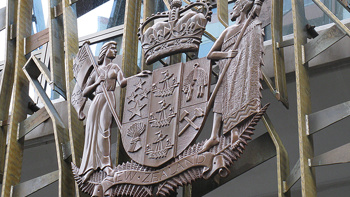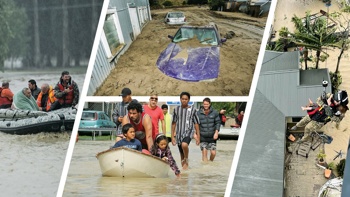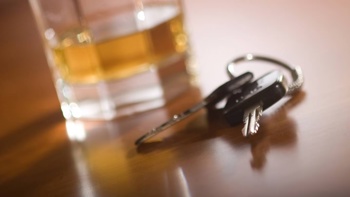Live bats were kept in cages inside the Wuhan Institute of Virology, contradicting the WHO's investigations into the origins of Covid-19.
As G7 countries increase calls for a "phase two" investigation into the origins of Covid-19, new footage has revealed that live bats were kept in cages inside the Wuhan Institute of Virology – despite claims from the World Health Organisation (WHO) that such a possibility was a "conspiracy".
The infamous lab is at the centre of a theory – first spruiked by the likes of Donald Trump and Mike Pompeo – that Covid-19 wasn't, as many scientists believe, transmitted from bats to people via an unknown intermediary, but was instead leaked, intentionally or not, from the institute.
A joint WHO/China investigation into the origins of the disease first worked to dispel this line of thinking, calling the chance of a laboratory leak "extremely unlikely" and the idea that bats were held at the institute "an error".

Caged bats inside the Wuhan Institute of Virology. (Photo / Supplied)
"No BATS were sent to Wuhan lab for genetic analysis of viruses collected in the field. That's not how this science works. We collect bat samples, send them to the lab. We RELEASE bats where we catch them," a member of the WHO team, zoologist Dr Peter Daszak, wrote in a December tweet.
"This is a widely circulated conspiracy theory. This piece describes work I'm the lead on and labs I've collaborated with for 15 years," he wrote in another.
"They DO NOT have live or dead bats in them. There is no evidence anywhere that this happened. It's an error I hope will be corrected."
But an official May 2017 video from the Chinese Academy of Sciences, obtained by Sky News, shows bats held in a cage at the institute four years ago and a scientist feeding a worm to one of the creatures.
Earlier this month, Daszak appeared to walk back his earlier denials, writing on Twitter that the WHO team had not asked the institute if they housed bats.

Footage of a scientist at the Wuhan Institute of Virology feeding a worm to a bat. (Photo / Sky News)
"We didn't ask them if they had bats. I wouldn't be surprised if, like many other virology labs, they were trying to set up a bat colony," he wrote.
"I know it's happening in labs here and in other countries. You're right, labs in US & around (the) world are trying to keep bats to test viral immune responses etc.
"None are successfully doing this at scale like lab mice & animals are always screened virus-free before expts, (sic) so even if WIV were trying this, it's prob irrelevant for origins."
'Zoonosis' still the most likely origin of Covid-19
While the lab leak theory has recently gained traction – despite no new scientific evidence – the prospect that Covid-19 jumped from bats into humans via an intermediate animal, a process known as "zoonosis", still remains the more likely scenario, experts have said.
"Plenty of other viruses have gone down this pathway before, including the original SARS and MERS, which are coronaviruses that have come across into humans," NSW director of public health pathology, Dominic Dwyer, told SBS News.
Dwyer, who travelled to Wuhan as part of the WHO delegation in January, said it is a "tried and true process".
"Nearly all human viruses identified in the last 40 or 50 years have come from animals in one form or another, and bats are a major contributor. So, there's a history there and it's well documented."
When the virus first emerged in late 2019, Chinese authorities reported that many of the cases occurred in Wuhan's Huanan Seafood Wholesale Market.
"A wet market scenario – where you have animals that are potentially infected by bats under enormous stress in cages, and there's a lot of people around often in crowded locations – is a perfect recipe for an outbreak," Dwyer said.

The Huanan Seafood Wholesale Market in Wuhan provided the 'perfect recipe for an outbreak'. (Photo / Getty Images)
Speaking to the Sydney Morning Herald earlier this month, Queensland University of Technology international wildlife law researcher, Dr Katie Woolaston, warned that allowing the lab leak theory to gain mainstream prominence could have serious consequences.
"The discourse detracts from the fact that epidemiologists and veterinary pathologists and other scientists in this area have been warning governments and the community for years that a zoonotic spillover with pandemic potential was increasingly likely to occur," she said.
"It takes focus away from the fact that the drivers of zoonotic spillover are human-induced environmental changes, and that needs to be addressed. I am concerned that an increased belief that the virus originated in a lab further detracts from the real and urgent need to enact preventative laws and policies."
'Transparency matters' in new investigation
At the G7 summit over the weekend, US President Joe Biden and other world leaders called for a "transparent, expert-led and science-based" second look into Covid-19 by the WHO in China.
Last month, Biden ordered national intelligence agencies to "redouble" their efforts to investigate the virus' origins, including "whether it emerged from human contact with an infected animal or from a laboratory accident".
"Transparency matters across the board," Biden said on Sunday.
"We haven't had access to the laboratories to determine whether or not – I've not reached a conclusion because our intelligence community is not certain whether or not this was a consequence of a – the marketplace, of bat interfacing with animals in the environment that caused this … or whether it was an experiment gone awry in [a] laboratory."

US President Joe Biden called for 'transparency' in a new WHO investigation into Covid-19's origins. (Photo / Getty Images)
Senior fellow at the US Studies Centre, John Lee, told SBS News that one of the reasons the lab leak theory was quickly dismissed "is because it was the preferred explanation of former president Donald Trump".
"That shouldn't have a bearing on how credible or not credible the theory is, but it has been politicised – initially by Donald Trump, and also by those who didn't like Donald Trump," he said.
What's needed, though, to give the theory any real weight, is "evidence to take the science further", Dwyer said.
"There have been suggestions about a whole range of different scenarios, including a deliberate or accidental leak, but the trouble with that is you have to be able to unpack that.
"You don't exclude these ideas, but you want to try and understand how they might arise and whether in the process of arising like that, that it makes sense.
"The damage with all of this is it stops co-operation and collaboration – that's how you solve scientific problems. And it can take time."
- text by Natalie Brown, news.com.au
Take your Radio, Podcasts and Music with you









